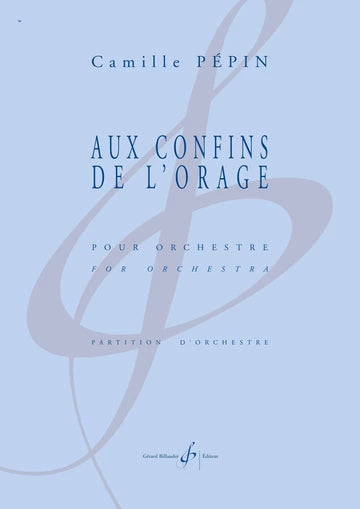Pépin: Aux Confins de l'orage
Expected to ship in 2-3 weeks.
- Composer: Camille Pépin (1990-)
- Format: Full Score
- Instrumentation: Orchestra
- Work: Aux Confins de l'orage
- ISMN:
Description
For my work Aux confins de l'orage I was inspired by three transitory light phenomena that precede a storm. They occur in the upper atmosphere and are invisible from the Earth (we can only observe flashes of lightning). To set to music my representation of them, I imagined orchestral colors specific to each one.
The Yellow-Orange Spheres are discs of light radiating in space in concentric circles. Arising from an electromagnetic impact in the ionosphere, they change color during their propagation, going from yellow to red-orange. I have represented this transformation by spherical chords traveling from one instrumental section to another. After the impact of the keyboards (harp, celesta, vibraphone), they are first played by the winds before extending to the front of the orchestra through the solo string quartet. Moving in the orchestra, they seem to hover above a celestial and motionless layer of strings. Thus, this slow movement introduces seven spherical chords that mark out the notes of the seminal motif of the piece. in this layer of the atmosphere farthest from us, the light is shimmering but fragile. Unstable, it flickers and soon a rumbling density appears, introducing the second movement.
From a thunderous aggregate are born the Red Sylphs, lower in the mesosphere. They are liquid and incandescent filaments flowing towards the Earth and resolving into intense red, luminous swirls. Played by the high-pitched woodwinds, these threads never vanish despite the explosions anticipating the storm (kettledrums, bass drum, low-pitched winds). Brass and strings alternatively present the chord-spheres. The elements come together as they ignite into a lyrical song based on the motif submerging the work. The flamboyant sky still glows a little before subsiding and returning to the slow and cold texture of the beginning of the work.
The last movement opens with a windy episode. Dark and mysterious with the orchestra's low-pitched colors, it provides the transition to the stratosphere. It is in this layer of the atmosphere closest to us that the Blue Jets fly at a hallucinating speed. These real light strokes, both brief and fast, are played by the woodwinds tinged with the brilliance of the keyboards. in the middle of this very lively movement, a suspended and cosmic moment appears, a brief lull before the storm. The horn takes up the motif of the spherical chords whose resonance permeates the woodwinds and then the muted strings. The material swells, radiates and one last time introduces the notes of this motif in a shattered chorale taken on by the brass instruments. Then, with a certain urgency, the dazzling blue jets resume their frantic race. As they approach the Earth, the sound becomes increasingly abrupt and dry. Finally, a last tumultuous rumble, a final thunderclap: the storm breaks out.
Camille Pépin
Publishers use a lot of words to describe what they sell, and we know it can be confusing. We've tried to be as clear as possible to make sure you get exactly what you are looking for. Below are descriptions of the terms that we use to describe the various formats that music often comes in.
Choral Score
A score for vocalists that only contains the vocal lines. The instrumental parts are not there for reference. Generally, cheaper than a vocal score and requires multiple copies for purchase.
Facsimile
Reproductions of the original hand-written scores from the composer.
Full Score
For ensemble music, this indicates that the edition contains all parts on a single system (there are not separate parts for each player). In larger ensembles, this is for the conductor.
Hardcover
Hardbound. Generally either linen-covered or half-leather.
Orchestral Parts
Similar to a wind set, this is a collection of parts. In the case of strings, the numbers listed are the number of copies included, though generally these are available individually (often with minimum quantities required).
Paperback
When publishers offer multiple bindings (e.g. hardcover) or study scores, this is the "standard" version. If you're planning to play the music, this is probably what you want.
Performance / Playing Score
A score of the music containing all parts on one system, intended for players to share. There are not separate parts for each player.
Set of Parts
For ensemble music, this indicates that there are separate individual parts for each player.
Solo Part with Piano Reduction
For solo pieces with orchestra, this is a version that contains a piano reduction of the orchestra parts. For piano pieces, two copies are typically needed for performance.
Study Score
A small (think choral size) copy of the complete score meant for studying, and not playing. They make great add-ons when learning concertos and small chamber works.
Vocal Score
A score prepared for vocalists that includes the piano/organ part or a reduction of the instrumental parts.
Wind Set
For orchestral music, this is a collection of wind and percussion parts. The specific quantities of each instrument are notated.
With Audio
In addition to the printed music, the edition contains recordings of the pieces. This may be an included CD, or access to files on the internet.
With / Without Fingering (Markings)
Some publishers prepare two copies - a pure Urtext edition that includes no fingering (or bowing) suggestions and a lightly edited version that includes a minimal number of editorial markings.


